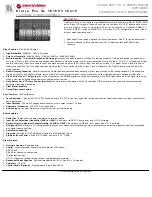
3-1
v1.0, June 2010
Chapter
3
Port Routing
In this chapter, the following examples are provided:
•
“Enable Routing for the Switch” on page
3-2
•
“Enable Routing for Ports on the Switch” on page
3-3
•
“Adding a Default Route” on page
3-6
•
“Adding a Static Route” on page
3-8
The first networks were small enough for the end stations to communicate directly. As networks grew, Layer
2 bridging was used to segregate traffic, a technology that worked well for unicast traffic, but had problems
coping with large quantities of multicast packets. The next major development was routing, where packets
were examined and redirected at Layer 3. End stations needed to know how to reach their nearest router, and
the routers had to understand the network topology so that they could forward traffic. Although bridges
tended to be faster than routers, using routers allowed the network to be partitioned into logical subnetworks,
which restricted multicast traffic and also facilitated the development of security mechanisms.
An end station specifies the destination station’s Layer 3 address in the packet’s IP header, but sends the
packet to the MAC address of a router. When the Layer 3 router receives the packet, it will minimally:
•
Look up the Layer 3 address in its address table to determine the outbound port
•
Update the Layer 3 header
•
Recreate the Layer 2 header
The router’s IP address is often statically configured in the end station, although the 7000 Series Managed
Switch supports protocols such as DHCP that allow the address to be assigned dynamically. Likewise, you
may assign some of the entries in the routing tables used by the router statically, but protocols such as RIP
and OSPF allow the tables to be created and updated dynamically as the network configuration changes.
Port Routing Configuration
The 7000 Series Managed Switch always supports Layer 2 bridging, but Layer 3 routing must be explicitly
enabled, first for the 7000 Series Managed Switch as a whole, and then for each port which is to participate
in the routed network.
The configuration commands used in the example in this section enable IP routing on ports 1/0/2,1/0/3, and
1/0/5. The router ID will be set to the 7000 Series Managed Switch’s management IP address, or to that of
any active router interface if the management address is not configured.
After the routing configuration commands have been issued, the following functions will be active:
















































